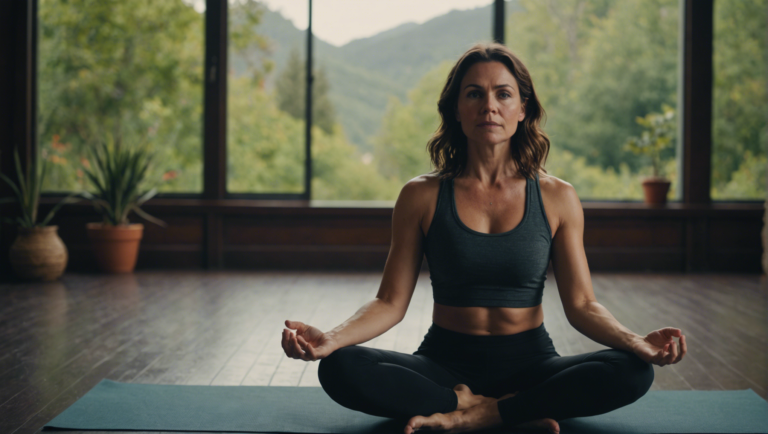Comprehensive Guidelines On How To Teach Yoga To Kids
Importance of Teaching Yoga to Kids
Teaching yoga to kids is incredibly significant for their overall well-being and development. In today’s fast-paced world, where children are constantly exposed to various stressors and distractions, introducing them to the practice of yoga early on can have numerous benefits that extend far beyond the mat.
Encouraging Physical Health and Fitness
One of the primary reasons why teaching yoga to kids is essential is the promotion of physical health and fitness. Yoga poses and sequences help improve flexibility, strength, coordination, and balance in children. By engaging in regular yoga practice, kids can develop healthy habits that support their physical well-being throughout their lives.
Promoting Emotional Regulation
Yoga is not just about physical postures; it also incorporates breathing techniques and mindfulness practices. Teaching these tools to children can help them learn how to manage their emotions better. Through yoga, kids can develop self-regulation skills, learn how to cope with stress and anxiety, and enhance their overall emotional well-being.
Enhancing Concentration and Focus
In today’s digital age, where distractions are abundant, cultivating concentration and focus is crucial for children. The practice of yoga involves mindfulness and awareness, which can significantly improve a child’s ability to concentrate both in school and in various activities. By teaching kids yoga, we empower them with the tools to enhance their focus and attention span.
Fostering Confidence and Self-Esteem
Yoga is a non-competitive practice that encourages self-expression and self-acceptance. By teaching kids yoga, we create a safe space for them to explore their capabilities, build confidence in their bodies, and nurture a positive self-image. The sense of accomplishment that comes from mastering a challenging pose or holding a balance posture can greatly boost a child’s self-esteem.
Cultivating Mind-Body Connection
Teaching yoga to kids helps them establish a strong connection between their minds and bodies. Through breath awareness and mindful movement, children learn to listen to their bodies, understand their physical limitations, and respect their inner selves. This mind-body connection not only improves physical performance but also promotes a deeper sense of self-awareness and introspection.
Instilling Healthy Lifestyle Habits
By introducing kids to yoga at a young age, we instill in them the importance of leading a healthy lifestyle. Yoga encourages mindful eating, adequate rest, and overall well-being beyond just physical exercise. These holistic teachings can have a lasting impact on a child’s lifestyle choices, setting the foundation for a lifetime of health and wellness.
The importance of teaching yoga to kids cannot be overstated. From promoting physical health and emotional regulation to enhancing concentration, confidence, and overall well-being, the benefits of yoga for children are vast and multifaceted. By incorporating yoga into children’s lives, we equip them with invaluable skills and tools that not only benefit them in the present moment but also set them up for a healthier, more balanced future.
Key Benefits of Yoga for Children’s Well-being
Yoga is a practice that offers numerous benefits for children’s overall well-being. It provides a holistic approach to physical and mental health, making it an excellent activity for kids to engage in. In this article, we will delve into the key advantages that yoga brings to children, promoting their health and happiness.
Enhances Flexibility and Strength
One of the primary benefits of yoga for children is improved flexibility and strength. Through various poses and movements, kids can enhance their range of motion and build muscle strength. These physical benefits not only support better posture and coordination but also aid in preventing injuries during other physical activities.
Promotes Emotional Regulation
Yoga teaches children how to connect with their emotions and develop self-regulation skills. By practicing mindfulness and deep breathing techniques, kids can learn to manage stress, anxiety, and overwhelming emotions effectively. This can lead to increased emotional resilience and a greater sense of inner peace.
Enhances Concentration and Focus
Through the practice of yoga, children can improve their concentration and focus. The mindfulness elements of yoga help kids stay present in the moment, enabling them to concentrate better on tasks at hand. This enhanced focus can benefit children both academically and in their daily activities.
Boosts Confidence and Self-Esteem
Engaging in yoga empowers children and boosts their self-confidence. As they master new poses and challenges, kids gain a sense of accomplishment and build self-esteem. The non-competitive nature of yoga encourages children to embrace their unique abilities and strengths, fostering a positive self-image.
Supports Better Sleep Quality
Yoga can contribute to improved sleep quality for children. The relaxation and meditation techniques practiced in yoga help calm the mind and prepare the body for restful sleep. Establishing a bedtime yoga routine can promote better sleep patterns, ensuring that children wake up feeling refreshed and energized.
Cultivates Mind-Body Awareness
Yoga promotes mind-body awareness in children, encouraging them to connect with their physical and emotional states. By tuning into their bodies and inner experiences, kids can develop a deeper understanding of themselves and cultivate a sense of self-awareness. This heightened awareness lays the foundation for overall well-being and healthy habits.
Fosters Social Connection
Yoga classes provide a supportive and inclusive environment for children to interact with their peers. Practicing yoga together fosters a sense of community and belonging, encouraging positive social connections. Kids can learn valuable social skills such as cooperation, communication, and empathy through group yoga sessions.
Yoga offers a myriad of benefits for children’s well-being, encompassing physical, mental, and emotional aspects. By incorporating yoga into their routine, children can experience improved flexibility, emotional regulation, concentration, confidence, sleep quality, mind-body awareness, and social connection. These holistic advantages make yoga a valuable practice for enhancing children’s overall health and happiness.
Practical Tips for Engaging Kids in Yoga Sessions
Engaging children in yoga sessions can be a rewarding and fun experience for both the kids and the instructor. By incorporating creative and interactive elements into the practice, children can not only benefit from the physical aspects of yoga but also develop focus, mindfulness, and emotional well-being. Here are some practical tips to make yoga sessions engaging and enjoyable for kids.
Importance of Making Yoga Fun and Engaging for Kids
When teaching yoga to children, it is crucial to create an environment that is welcoming, non-intimidating, and, most importantly, fun. Unlike adult yoga classes, children have shorter attention spans and a natural inclination towards play. Hence, incorporating games, storytelling, music, and props can make the yoga sessions more interactive and stimulating for kids.
Themes and Storytelling
One effective way to engage kids in yoga is by introducing themes and storytelling into the sessions. Consider creating imaginative stories or narratives that resonate with children and weave yoga poses into the storyline. For example, you can take the kids on a magical adventure where they mimic animal poses or act out different elements of nature through yoga.
Use of Props and Visual Aids
Utilizing props and visual aids can add an element of excitement and creativity to yoga sessions for kids. Items such as colorful mats, animal-themed props, stickers, or even soft toys can make the practice more engaging and visually appealing for children. Props can also help kids understand and achieve proper alignment in various yoga poses.
Encouraging Creativity and Expression
Children are inherently creative and expressive beings. Encouraging them to express themselves through movement, art, or even vocalizations during yoga can enhance their overall experience. Allow kids to add their unique flair to the practice by suggesting creative variations or asking them to come up with their mini sequences.
Practicing Mindfulness and Relaxation Techniques
While it’s essential to make yoga sessions engaging and dynamic, it’s equally important to incorporate mindfulness and relaxation techniques into the practice. Teaching kids deep breathing exercises, guided visualizations, or simple meditation practices can help them cultivate self-awareness, reduce stress, and improve concentration.
Cultivating a Positive and Supportive Environment
Creating a positive and supportive environment is key to engaging kids in yoga. Offer words of encouragement, praise their efforts, and foster a sense of community within the group. By cultivating a safe and inclusive space, children are more likely to feel comfortable, confident, and willing to participate actively in the practice.
Engaging kids in yoga sessions requires creativity, patience, and a genuine passion for working with children. By making yoga fun, interactive, and meaningful, you can instill a love for yoga in young minds and sow the seeds for a lifelong practice of health and well-being.
Incorporating Fun and Creativity in Kids Yoga Classes
Yoga can be a fantastic way for kids to engage in physical activity while also connecting with their inner selves. When teaching yoga to children, incorporating elements of fun and creativity can make the classes more enjoyable and beneficial for the young yogis. By introducing playfulness and imaginative activities into kids’ yoga sessions, instructors can create an environment where children are excited to participate and reap the numerous benefits that yoga has to offer.
The Importance of Fun and Creativity in Kids Yoga Classes
Fun and creativity into kids’ yoga classes is essential for several reasons. Firstly, children have shorter attention spans compared to adults, and traditional yoga classes may not always captivate their interest. By introducing fun and creative elements into the sessions, instructors can keep the children engaged and motivated throughout the class.
Engaging Activities and Games
One way to introduce fun into kids’ yoga classes is by incorporating engaging activities and games. For example, playing yoga-themed games such as "Yogi Says" or "Musical Mats" can add an element of excitement to the class while also allowing children to practice different yoga poses in a playful manner. Additionally, incorporating storytelling into yoga sessions can capture the children’s imagination and make the practice more relatable and enjoyable for them.
Music and Movement
Another effective way to make kids’ yoga classes more enjoyable is by incorporating music and movement into the sessions. Playing upbeat and age-appropriate music during the practice can energize the children and make the yoga session more dynamic. Encouraging the children to move in creative ways, such as animal-inspired movements or dance sequences, can also help them connect with their bodies and express themselves during the practice.
Artistic Expression and Visualization
Integrating artistic expression and visualization techniques into kids’ yoga classes can stimulate their creativity and imagination. Encouraging children to draw or paint their yoga experiences can help them express their feelings and experiences in a visual way. Guided visualization activities, where children imagine themselves in different settings or scenarios, can also enhance their focus and relaxation during the practice.
Building a Supportive and Inclusive Environment
Creating a supportive and inclusive environment is crucial when teaching yoga to kids. Instructors should foster a sense of belonging and acceptance in the class, encouraging children to support and cheer for each other during the practice. By promoting positive interactions and teamwork, instructors can cultivate a safe and welcoming space where children feel comfortable exploring yoga and expressing themselves freely.
Incorporating fun and creativity into kids’ yoga classes can enhance the overall experience for young practitioners. By introducing engaging activities, music and movement, artistic expression, and a supportive environment, instructors can create a positive and enriching atmosphere where children can learn, grow, and enjoy the practice of yoga. Through playful and imaginative approaches to teaching yoga, instructors can inspire a love for yoga in children and set them on a path to lifelong health and well-being.
Addressing Challenges When Teaching Yoga to Kids
Teaching yoga to kids can be a rewarding experience, but it also comes with its own set of challenges that instructors need to address to ensure a positive and engaging learning environment for the young practitioners.
Understanding the Attention Span of Children
Children have shorter attention spans compared to adults, which can make it challenging to keep them focused during a yoga class. To address this challenge, instructors can incorporate interactive and fun elements into their lessons to capture and maintain the children’s interest. Utilizing games, storytelling, and music can help make the practice more engaging and enjoyable for the young yogis.
Creating a Safe and Supportive Environment
Safety is paramount when teaching yoga to kids. It is crucial to create a safe and supportive environment where children feel comfortable exploring and trying out different poses. Instructors should communicate clearly and encourage open communication to ensure that children feel empowered to speak up about any discomfort or concerns during the practice.
Adapting Poses for Children
Children’s bodies are still developing, so it’s essential to modify yoga poses to suit their unique needs. Instructors should focus on teaching poses that are appropriate for children’s flexibility and strength levels. Encouraging proper alignment and offering variations for different skill levels can help ensure that all children can participate safely and confidently in the practice.
Maintaining Engagement and Interaction
Keeping children engaged throughout the yoga class is key to a successful teaching experience. partner poses, group activities, and mindfulness exercises can help maintain the children’s interest and promote interaction among the students. Creating a dynamic and interactive learning environment can enhance the overall learning experience for the young practitioners.
Building Trust and Connection
Establishing trust and connection with the children is essential for effective teaching. Instructors should strive to build rapport with their students, show empathy, and create a supportive atmosphere where children feel valued and respected. By fostering a sense of trust and belonging, instructors can create a positive and nurturing space for children to explore yoga and develop their practice.
Encouraging Playfulness and Creativity
Yoga for kids should be a playful and creative experience that allows children to express themselves freely. Instructors can encourage imaginative play, creative movements, and self-expression within the practice to make it more engaging and enjoyable for the young yogis. Embracing the playful nature of children can help them connect with the practice on a deeper level and foster a lifelong love for yoga.
Teaching yoga to kids requires patience, creativity, and a deep understanding of children’s unique needs and characteristics. By addressing the challenges associated with teaching yoga to kids and implementing strategies to overcome them, instructors can create a fun, safe, and engaging environment where children can experience the benefits of yoga practice at a young age.
Conclusion
Fun and creativity into kids’ yoga classes is essential for engaging them fully in the practice. By introducing exciting themes, playful poses, storytelling, and interactive games, children are more likely to stay focused and enjoy the sessions. Encouraging imagination and creativity also nurtures a love for yoga at a young age, setting a strong foundation for a lifelong practice.
As with any form of teaching, there are challenges that may arise when instructing yoga to kids. It is crucial to be patient, adaptable, and understanding of their varying attention spans and energy levels. Addressing any disruptive behavior with positivity and redirection rather than reprimanding creates a supportive and inclusive environment for all children to participate comfortably. Flexibility and a sense of humor can go a long way in handling unexpected situations during classes.
Teaching yoga to kids is a rewarding experience with numerous benefits for their overall well-being. By recognizing the importance of introducing yoga at a young age, we can contribute to the development of healthier and more balanced individuals. The key benefits of yoga for children, including improved physical health, mental well-being, emotional regulation, and social skills, highlight the significance of integrating yoga into their routine.
Moreover, practical tips for engaging kids in yoga sessions provide valuable strategies for creating a positive and enjoyable learning environment. fun and creativity not only enhances their experience but also fosters a lifelong passion for yoga. While challenges may arise, approaching them with patience, flexibility, and a sense of humor can effectively overcome any obstacles in teaching yoga to kids.
In essence, teaching yoga to children is a holistic endeavor that encompasses physical, mental, emotional, and social aspects of their development. By embracing the comprehensive guidelines and principles discussed, instructors can inspire a love for yoga in young minds and empower them with valuable tools for a healthier lifestyle. Let us continue to nurture the well-being of the next generation through the practice of yoga, guiding them towards a path of harmony, resilience, and inner peace.


